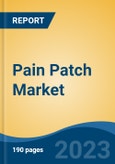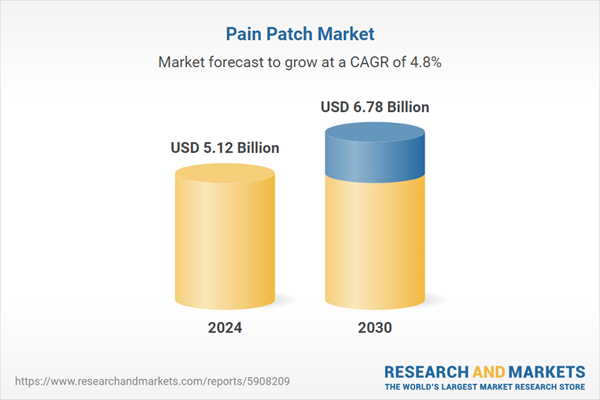Free Webex Call
The Pain Patch Market was valued at USD 5.12 Billion in 2024, and is expected to reach USD 6.78 Billion by 2030, rising at a CAGR of 4.76%. Pain patches have emerged as a convenient and effective solution for managing various forms of pain, offering an alternative to traditional oral medications. These patches deliver localized relief through transdermal drug delivery systems, making them an attractive option for individuals seeking comfort and convenience in pain management. The global pain patch market has experienced substantial growth in recent years, driven by factors such as the increasing prevalence of chronic pain conditions, an aging population, and a growing demand for non-invasive pain management solutions. Speak directly to the analyst to clarify any post sales queries you may have.
10% Free customizationThis report comes with 10% free customization, enabling you to add data that meets your specific business needs.
Chronic pain conditions, such as arthritis, back pain, neuropathic pain, and fibromyalgia, are on the rise globally. Pain patches offer a targeted approach to manage chronic pain without the side effects associated with oral medications, contributing to their popularity. As the global population ages, there is a higher incidence of age-related pain conditions. Elderly individuals often prefer pain patches as they are easy to apply and provide sustained relief without the need for frequent dosing. Pain patches are non-invasive and offer a discreet way to manage pain without the need for injections or pills. This appeals to patients looking for alternative methods of pain relief.
Ongoing research and development in drug delivery technologies have led to more efficient and long-lasting pain patch formulations. These patches can now deliver a variety of medications, including opioids, non-steroidal anti-inflammatory drugs (NSAIDs), and muscle relaxants. Pharmaceutical companies and medical device manufacturers are continuously expanding their pain patch product portfolios. This includes the development of patches for specific pain types and the introduction of innovative features such as smart patches that monitor and adjust drug delivery based on the patient's needs.
Key Market Drivers
Rising Prevalence of Chronic Pain is Driving the Global Pain Patch Market
Chronic pain is a widespread and debilitating condition that affects millions of people worldwide, significantly impacting their quality of life. As the global population continues to age and the incidence of chronic conditions such as arthritis, back pain, and neuropathy rises, the demand for effective pain management solutions is on the rise. One such solution that is gaining traction in the healthcare industry is the pain patch.These transdermal patches are becoming increasingly popular due to their convenience, effectiveness, and ability to provide consistent pain relief. According to Centers for Disease Control and Prevention, in 2021, approximately 20.9% of U.S. adults, equating to 51.6 million people, reported experiencing chronic pain. Of these, 6.9% (17.1 million individuals) experienced high-impact chronic pain, which significantly restricts daily activities. The prevalence of chronic pain was notably higher among non-Hispanic American Indian or Alaska Native
Key Market Challenges
Pricing and Reimbursement
The pricing of pain patches is a major challenge in the healthcare market, particularly in regions where there is a strong emphasis on cost containment and budget restrictions within public and private healthcare systems. Manufacturers of pain patches must navigate complex pricing structures while attempting to keep their products affordable for a wide range of patients. Reimbursement policies from insurance companies significantly influence the accessibility of pain patches to patients.If insurance plans do not cover certain treatments or if the reimbursement rates are low, patients may be less likely to afford these products, thereby limiting market reach. Additionally, the negotiation process between manufacturers and insurers can affect the final pricing, potentially influencing the uptake of pain patches in both institutional and consumer markets. Therefore, manufacturers are tasked with balancing product quality and affordability, which requires ongoing adaptation to changing market dynamics and reimbursement structures.
Key Market Trends
Technological Advancements
The global healthcare industry is witnessing a significant transformation, driven by rapid technological advancements and a growing emphasis on patient-centric solutions. One notable area where these changes are manifesting is in the pain management sector. Traditional methods of pain relief, such as oral medications, injections, and physical therapy, are now being complemented and, in some cases, replaced by innovative solutions like pain patches. These patches are gaining traction in the global market due to their convenience, effectiveness, and advancements in their technology. In January 2021, Hisamitsu Pharmaceutical Co., Inc. declared that it had received approval for modifying certain aspects of the previously approved specifications for their new transdermal analgesic anti-inflammatory patches, known as "Mohrus Paps XR 120 mg and 240 mg." This adjustment aimed to alleviate the irritation caused by the current additives.Key Market Players
- NEXGEL Inc.
- Viatris Inc.
- Johnson and Johnson
- Teva Pharmaceutical Industries Ltd.
- Sorrento Therapeutics Inc.
- Hisamitsu Pharmaceutical Co., Inc.
- Endo, Inc.
- Purdue Pharma L.P.
- Amneal Pharmaceuticals LLC
- Grünenthal GmbH
Report Scope:
In this report, the Global Pain Patch Market has been segmented into the following categories, in addition to the industry trends which have also been detailed below:Pain Patch Market, By Product Type:
- Non-Opioid Patches
- Opioid Patches
Pain Patch Market, By Type:
- Prescription Medicines
- OTC Medicines
Pain Patch Market, By Distribution Channel:
- Hospital Pharmacies
- Drug Stores and Retail Pharmacies
- Online Providers
Pain Patch Market, By Region:
- North America
- United States
- Canada
- Mexico
- Europe
- France
- United Kingdom
- Italy
- Germany
- Spain
- Asia-Pacific
- China
- India
- Japan
- Australia
- South Korea
- South America
- Brazil
- Argentina
- Colombia
- Middle East & Africa
- South Africa
- Saudi Arabia
- UAE
Competitive Landscape
Company Profiles: Detailed analysis of the major companies present in the Pain Patch Market.Available Customizations:
With the given market data, the publisher offers customizations according to a company's specific needs. The following customization options are available for the report.Company Information
- Detailed analysis and profiling of additional market players (up to five).
This product will be delivered within 1-3 business days.
Table of Contents
1. Product Overview
2. Research Methodology
3. Executive Summary
5. Global Pain Patch Market Outlook
6. North America Pain Patch Market Outlook
7. Europe Pain Patch Market Outlook
8. Asia-Pacific Pain Patch Market Outlook
9. South America Pain Patch Market Outlook
10. Middle East and Africa Pain Patch Market Outlook
11. Market Dynamics
12. Market Trends & Developments
13. Porter’s Five Forces Analysis
14. Competitive Landscape
Companies Mentioned
- NEXGEL Inc.
- Viatris Inc.
- Johnson and Johnson
- Teva Pharmaceutical Industries Ltd.
- Sorrento Therapeutics Inc.
- Hisamitsu Pharmaceutical Co., Inc.
- Endo, Inc.
- Purdue Pharma L.P.
- Amneal Pharmaceuticals LLC
- Grünenthal GmbH
Table Information
| Report Attribute | Details |
|---|---|
| No. of Pages | 185 |
| Published | February 2025 |
| Forecast Period | 2024 - 2030 |
| Estimated Market Value ( USD | $ 5.12 Billion |
| Forecasted Market Value ( USD | $ 6.78 Billion |
| Compound Annual Growth Rate | 4.7% |
| Regions Covered | Global |
| No. of Companies Mentioned | 10 |









